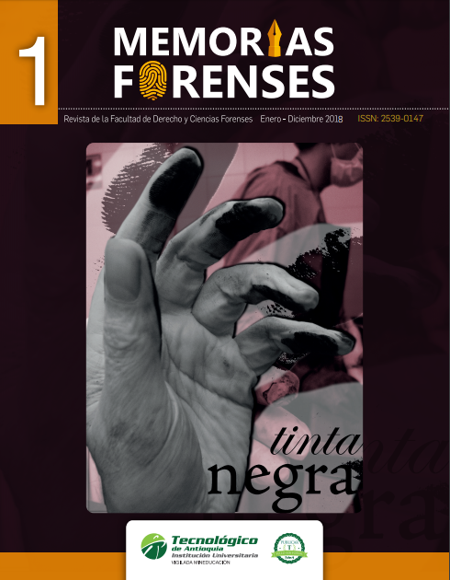Método Taguchi para optimizar la amplificación de la región código de barras de ADN en moscas de importancia forense (Diptera: Calliphoridae)
Taguchi method in the optimization of the DNA barcode region amplification in forensic important flies (Diptera: Calliphoridae)
Contenido principal del artículo
Resumen
Descargas
Detalles del artículo
Referencias (VER)
Aggarwal, S. (2008). Short tandem repeat genotyping. En Techniques in Molecular Biology (pp. 127-134). Lucknow: International Book Distributing CO.
Amat, E., Vélez, M. C., & Wolff, M. (2008). Clave ilustrada para la identificación de los géneros y las especies de califóridos (Diptera: Calliphoridae) de Colombia. Caldasia, 30(1),
-244.
Amendt, J., Richards, C. S., Campobasso, C. P., Zehner, R., & Hall, M. J. R. (2011). Forensic entomology: Applications and limitations. Forensic Science, Medicine, and Pathology, 7(4),
-392. https://doi.org/10.1007/s12024-010-9209-2
Asghar, U., Malik, M. F., Anwar, F., Javed, A., & Raza, A. (2015). DNA Extraction from Insects by Using Different Techniques: A Review. Advances in Entomology, 3, 132-138.
Ausubel, F. M., Brent, R., Kingston, R. E., Moore, D. D., Seidman, J. G., Smith, J. a, €¦ Blackshaw, S. (2003). Current Protocols in Molecular Biology. Molecular Biology (Vol. 1). New York. https://doi.org/10.1002/mrd.1080010210
Ball, S. L., & Armstrong, K. F. (2008). Rapid, one-step DNA extraction for insect pest identification by using DNA barcodes. Journal of Economic Entomology, 101(2),
-532.
Bartlett, J. M. S., & Stirling, D. (2003). A short history of the polymerase chain reaction. Methods in Molecular Biology, 226, 3-6. https://doi.org/10.1385/1-59259-384-4:3
Benecke, M. (2001). A brief history of forensic entomology. Forensic Science International, 120(1-2),
-14. https://doi.org/10.1016/S0379-0738(01)00408-X
Celani de Souza, H. J., Borges Silva, M., Moyses, C. B., Lopes Alberto, F., Pontes, F. J., Ferreira, U. R., €¦ Sanches da Silva, C. E. (2013). Robust Design and Taguchi Method Application. En M. Borges Silva (Ed.),
Design of Experiments - Applications (pp. 1-20). InTech.
Cobb, B. D., & Clarkson, J. M. (1994). A simple procedure for optimising the polymerase chain reaction (PCR) using modified Taguchi methods. Nucleic Acids Research, 22(18),
-3805. https://doi.org/10.1093/nar/22.18.3801
Condamine, F. L., Clapham, M. E., & Kergoat, G. J. (2016). Global patterns of insect diversification: towards a reconciliation of fossil and molecular evidence? Scientific Reports, 6, 19208. https://doi.org/10.1038/srep19208
Dean, M. D., & Ballard, J. W. O. (2001). Factors affecting mitochondrial DNA quality from museum preserved Drosophila simulans. Entomologia Experimentalis et Applicata, 98(3),
-283.
Folmer, O., Black, M., Hoeh, W., Lutz, R., & Vrijenhoek, R. (1994). DNA primers for amplification of mitochondrial cytochrome c oxidase subunit I from diverse metazoan invertebrates. Molecular Marine Biology and Biotechnology, 3, 294-299. https://doi.org/10.1371/journal.pone.0013102
Gutiérrez-López, R., Martínez-de la Puente, J., Gangoso, L., Soriguer, R. C., & Figuerola, J. (2015). Comparison of manual and semi-automatic DNA extraction protocols for the barcoding characterization of hematophagous louse flies (Diptera: Hippoboscidae). Journal of Vector Ecology, 40(1),
-15. https://doi.org/10.1111/jvec.12127
Hebert, P. D. N., Cywinska, A., Ball, S. L., & DeWaard, J. R. (2003). Biological identifications through DNA barcodes. Proceedings. Biological Sciences / The Royal Society, 270, 313-321. https://doi.org/10.1098/rspb.2002.2218
Joseph, I., Mathew, D., Sathyan, P., & Vargheese, G. (2011). The use of insects in forensic investigations: An overview on the scope of forensic entomology. Journal of Forensic Dental Sciences, 3(2),
-91. https://doi.org/10.4103/0975-1475.92154
Nakano, A., & Honda, J. (2015). Use of DNA sequences to identify forensically important fly species and their distribution in the coastal region of Central California. Forensic Science International, 253, 1-13. https://doi.org/10.1016/j.forsciint.2015.05.001
Neumaier, M., Braun, A., & Wagener, C. (1998). Fundamentals of quality assessment of molecular amplification methods in clinical diagnostics. Clinical Chemistry, 44(1),
Packer, L., Gibbs, J., Sheffield, C., & Hanner, R. (2009). DNA barcoding and the mediocrity of morphology. Molecular Ecology Resources, 9(Suppl. 1),
-50. https://doi.org/10.1111/j.1755-0998.2009.02631.x
Promega. (2016). PCR Amplification. Recuperado de https://worldwide.promega.com/resources/product-guides-and-selectors/protocols-and-applications-guide/pcr-amplification/
Rao, R. S., Kumar, C. G., Prakasham, R. S., & Hobbs, P. J. (2008). The Taguchi methodology as a statistical tool for biotechnological applications: A critical appraisal. Biotechnology Journal. https://doi.org/10.1002/biot.200700201
Ratnasingham, S., & Hebert, P. D. N. (2007). BOLD: The Barcode of Life Data System: Barcoding. Molecular Ecology Notes, 7, 355-364. https://doi.org/10.1111/j.1471-8286.2007.01678.x
Sambrook, J., Fritsch, E. F., & Maniatis, T. (2001). Molecular Cloning: A Laboratory Manual. New York (3rd ed.). New York: Cold Spring Harbor Laboratory Press. https://doi.org/574.873224 1/1989
Schwarz, C., Debruyne, R., Kuch, M., Mcnally, E., Schwarcz, H., Aubrey, A. D., €¦ Poinar, H. (2009). New insights from old bones: DNA preservation and degradation in permafrost preserved mammoth remains. Nucleic Acids Research, 37(10), 3215-3229. https://doi.org/10.1093/nar/gkp159
Sharma, P., & Kobayashi, T. (2014). Are “universal” DNA primers really universal? Journal of Applied Genetics, 55(4),
-496. https://doi.org/10.1007/s13353-014-0218-9
Sperling, F. A., Anderson, G. S., & Hickey, D. A. (1994). A DNA-based approach to the identification of insect species used for postmortem interval estimation. Journal of Forensic Sciences, 39(2),
-427.
Swinehart, D. F. (1962). The Beer-Lambert Law. Journal of Chemical Education, 39(7),
https://doi.org/10.1021/ed039p333
Taguchi, G., & Konishi, S. (1987). Taguchi Methods: Orthogonal Arrays and Linear Graphs. Dearborn, Michigan, USA: American Supplier Institute.
Watson, J. D., & Crick, F. H. C. (1953). Molecular structure of nucleic acids. Nature. https://doi.org/10.1097/BLO.0b013e3181468780
Watts, P. C., Thompson, D. J., Allen, K. A., & Kemp, S. J. (2007). How useful is DNA extracted from the legs of archived insects for microsatellite-based population genetic analyses? Journal of Insect Conservation, 11(2),
-198. https://doi.org/10.1007/s10841-006-9024-y
Wells, J. D., & Sperling, F. a H. (2001). DNA-based identification of forensically important Chrysomyinae (Diptera: Calliphoridae). Forensic Science International, 120(1-2),
-115. https://doi.org/10.1016/S0379-0738(01)00414-5
Wells, J. D., & Stevens, J. R. (2008). Application of DNA-based methods in forensic entomology. Annual Review of Entomology, 53, 103-120. https://doi.org/10.1146/annurev.ento.52.110405.091423
Whitworth, T. (2014). A revision of the Neotropical species of Lucilia Robineau-Desvoidy (Diptera: Calliphoridae). Zootaxa (Vol. 3810). https://doi.org/10.11646/zootaxa.3810.1.1
Wilfinger, W. W., Mackey, K., & Chomczynski, P. (1997). Effect of pH and ionic strength on the spectrophotometric assessment of nucleic acid purity. BioTechniques, 22(3),
-481.










